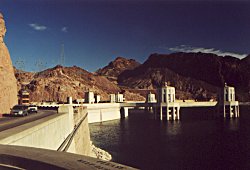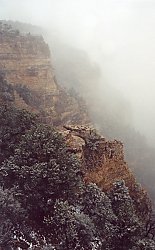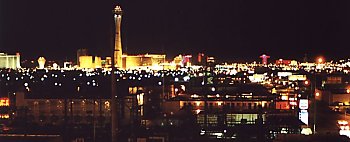
Dust, blisters and neon: the desert story
Early the afternoon I board my first Greyhound in San Jose, and leave south on the 101. In a light drizzle we turn to smaller roads at Gilroy, winding between farmlands, pastures and trees. At times we are in the hills, then next to blue dams, the grass still green in the Californian spring.
We arrive in Los Angeles late the night, and I wait in a scruffy station for my connection to Las Vegas. Weird people abound. An emancipated hustler tries to sell a youth a fake necklace, with an 'Hey man, lets get out of here' to his accomplice he disappears, confused security guards trying to find him.
Around midnight the Vegas bus stops at a convenience store in the desert. An oasis of bright light in a dome of darkness threatening unknown evils. Bat country, I assume. At the state line a bunch of Casinos promise of things to come, then disappears again, leaving ghost-images of special room-rates on my retinas every time I blink in the dark.
Four in the morning we arrive in a dazed Las Vegas. From where the bus enters, I see none of the bright lights I expected, just the traveller’s lounge of steel benches and vending machines of a bus stop. With my two huge bags I wander through the nearest Casino, looking for a place to eat.
After a pathetic breakfast, I see the local bus stop right in front; it should take me to the airport for a fraction of the price of a taxi. I wait in a freezing wind. At the airport I get my car, a brand new Protégé, 3 miles on the odometer. I leave for the Hoover dam.
Still lightly shell-shocked from no sleep, seeing places I never dreamed I would see and driving on the right-hand side of the road, I drive over the wall as recommended by my guidebook, the parking on the Arizona side is free and plentiful.
Walking back over the dam wall, I am reminded of the feeling of the Northern Cape, this huge mass of water in the desert rocks. Later the Colorado would remind me even more of the Orange River as it carves through the Richtersveld.
But this is on a scale of it’s own. Oddly enough, here the dam wall has a different name from the lake it creates. So it is Hoover Dam, Lake Mead. The water is crystal clear, huge fish lazing in the shallows where the law keeps fishermen at bay. The huge cement mass disappearing into the gorge below.
I take a tour of the dam, and we go with an elevator to the bottom, see the turbine hall, and are told about the dam. Afterwards I am shocked by the prices in the store, and leave for Kingman. The road got monotone beyond belief. Twice I pulled over and rested for a few minutes, lest I fall asleep behind the wheel. At Kingman I take Route 66. Immediately driving became more interesting.
Whereas the I-93 from the Hoover dam to Kingman was a big, straight highway, Route 66 started to wind through hills. Small ghost gas stations bleach further in the sun, supposed towns like Hackberry cannot be found. I stop in Peach Springs, a small town in the Hualapai Indian Reserve, but there is not much to see.
In Seligman I stop the Road Kill Cafe, eat a burger and browse through some store selling everything from hardware to cattle sculls. At Williams I take an interesting detour through the town thanks to the confusing road signs, and head North to the Grand Canyon.
The first time you see the canyon it is truly unbelievable. Standing on the very edge, looking down the first set of cliffs, the height is fantastic. But it is when you look straight at the North rim, when the amazing feeling of the space before you really hits home. Here being able to fly is more than a dream, it becomes a physical necessity. The cliffs are painted in different colours from dark red to light brown, as the rock layers change. It is time travel before your eyes, as you descend the time goes back and back. Dazed by the place, I walk around on the rim, staring and taking photos a bit like a zombie.
That night it becomes very cold. Still, I sleep like the dead. Well, after the RVs shut of their generators. I ate quite simple, as you do on a hike. Cup noodles, instant noodles with to peas in a cup, just add boiling water. The camp is mostly filled with the huge RVs, TV satellite and microwave equipped, towing cars behind them.
The next morning I got up a bit late. Since there are no sinks for dishwashing I washed my dishes in a modified 1-gallon water bottle, and then flushed the water down the toilet, as per regulations.
 After I packed up and got to the backcountry use office, there was no more permits available to sleep at the Bright Angel campground that night, so I got my permit for the next two nights, and went to pitch my tent again.
After I packed up and got to the backcountry use office, there was no more permits available to sleep at the Bright Angel campground that night, so I got my permit for the next two nights, and went to pitch my tent again.
About this time the weather started to deteriorate fast, and by mid-afternoon it was snowing with an icy wind on top. At the rim you could not see down beyond the first drop. I explore some of the rim attractions, and ride around with the free shuttle buses. All the major rim view points, shops, hotels, visitor centres and parking lots are connected with a free bus system. This way I almost never drive while I am there. Still, you would see people driving their bus-sized RV from place to place, not able to forgo satellite TV for a second.
The supermarket has everything: from $50 walking sticks to food, cloves and hardware. At another store I listen to Native American Indian music, and browse through their collection of books. Every time I go into a building I have to take of 90% of my clothes, otherwise I would boil to death. Outside the snow accumulates in my hair, only to melt as I go inside.
With news flashes from long ago stories of hikers getting lost in the snow of the Drakenberg milling through my mind, I buy crampons and other cold weather equipment, not knowing the trail or conditions ahead. I go to the rim, dressed in my warmest clothes, the wind being much much colder than when I went skiing earlier at Lake Tahoe. Without the jacket my sister borrowed me, I would have frozen. At the rim, I talk to people who are only stopping for an hour; they see nothing more than the mist. They are wearing only shorts and T-shirts, I guess if you only get out of the car for 5 minutes it can be done. I help them by taking a photo of the two with the white wall where the canyon is supposed to be in the background with their camera, the sum of their Grand Canyon experience.
Later, at sunset, it started to look a lot better, and most of the Canyon was visible again. First clear, but still in shadow with snow covering the trees. Then the sun came out for a few minutes, just before it set.
Fortunately I had a good sleeping bag borrowed from my sister, and I bought myself a new tent in anticipation of cold. The next morning I wake up to a steady patter on the tent. Fearing rain I waited some time before getting up, and discovered it was small drops of ice, falling on top of the bit of snow that fell through the night. By the time I packed up and arrive at the trailhead, things are looking much better, but still very cold.
After helping a large party of hikers getting photos of them all, and getting a photo taken of me with my camera, I start down the South Kaibab trail, 11 km in length, with a change in elevation of 1.4km, on my way to spend the night at the Bright Angel campground on the other side of the Colorado. There are still a few patches of snow around, and a wind that forces me to wear a ski jacket.
Immediately the trail starts with a series of switchbacks, something I got to know very well over the next three days. As I descend the Canyon conditions improve the whole time, and I make good time down. It becomes hotter and hotter the whole time, and about halfway down I take of the jacket. The hikers also become less and less, as the day-trippers turn back. Twice mule trains from the bottom come past. The trees of the rim give way to a more desert type vegetation, aloes, shrubs and suchlike.
As I neared the river it becomes obvious that I should have packed shorts, it became quite hot. With extremely tired legs and feet starting to hurt I arrive at the river, and realize that I should not have rushed it like I did. After crossing the river on one of the two suspension bridges, I get to the campground. It is stretched out next to a side creek flowing into the Colorado, in the shade of some trees.
There are few spots to choose from, but I find a pleasant enough place for my tent. As I take off my shoes, I discover both my big toes have tremendous blisters. I wash my feet in the little stream running past the campground, watched by a tame deer grazing on a small island in the middle.
Dinner is once again instant noodles and canned food, and a slight revulsion with cup noodles already starts to set in. Afraid that my blisters might burst while hiking the next day, I drain them, and try not to walk any more. Al food must be stored in locked containers for the wild animals, but I do not see any.
The next morning after I broke camp, I head to the river, and leave the trail to at least put my hand in the water. It just feels wrong to walk all that way without feeling the river. Once I crossed the suspension bridge I did not use the day before, I find a nice spot overlooking the river and have a magnificent breakfast of fig wallops, banana chips and water. The day's hike is about 8km, with a rise in elevation of 430m.
Right after crossing the bridge the trail leads along side the river for some way, and every time I come to a down-hill section I feel my toes hurting in my boots. Halfway up I rest beside a clear mountain stream in the shade of a rock overhang.
Four hours later I arrive at the Indian garden campground, and lay in the shade of the shelter of my camping spot, peaceful while people trim trees with chainsaws all around me. I feel really tired, my legs aching.
That night I speak with four women who hiked to the Indian Garden campground the day before, and then hiked to the river and back that day. It seems to be a good way to do it. The chainsaw gang have since stopped, and after some more cup noodles and canned meat for dinner I am truly in need of some good food. Hearing me complain, the four give me a piece of chocolate. I wake up in the bowl of mountains, and start up the trail full of determination and a power breakfast.
After the cups of noodles I ingested the previous night, the summer sausage seems from heaven. This is supposed to be the hardest day, starting 2/3 of the way down the Canyon. The length of the hike for the day is only 7.4 Km, but I have to climb 900m with my stiff legs. The sight of the mountain above me made me wonder what the hell I am doing this for. The trail is impossible to see from the bottom, and it seems like there are parts where it must rise on the sheer cliff walls.
But switchback follow switchback, and frequently I would look back, and see a spot I left an hour ago only a few hundred meters away, but a few hundred meters below. I make sure I stop every mile and a half for water and food, and start to feel positively energetic on my way up.
As I get that feeling of nearing the end, dreaming of a big plate of food, I get people looking at my pack, asking where I started. Quite blasé I would describe my hike to each and everyone willing to listen. Exiting into the parking lot at the Bright Angel lodge, I get someone to take a final photo of me with the trail sign, and after listlessly standing around not really knowing what next, I wait for the shuttle bus back to my car.
I buy myself the biggest lunch I can find, get my tent ready for the night, and buy dinner. I would not eat another cup of noodles the entire trip. One thing I did not do correct was my planning of food, and I got a lesson I will remember.
Early the next morning I break camp for the last time, have a final look at the canyon, and leave for Las Vegas. The road back is uneventful. After returning my car, I struggle with my luggage to the bus stop at the airport, and head back into town. It seems like a good idea to stay as near as possible to the Greyhound station, and I find a place just opposite.

The hotel as a slightly run-down feel to it, with a few token slot machines and a decrepit bar selling drinks two for one after midnight. My room is on the top floor, with a large mirror above the bed. After my shower, I leave for the nearby ‘Fremont experience’, a walkway lined with casinos and expensive touristy crap for sale.
In Vegas, as in Reno, they have eat-as-much-as-you-like buffets for little money, and much better food than instant noodles. After gorging myself on everything in sight, I walk down Las Vegas Boulevard to the strip, a distance I underestimated, take a bus back, and turn in for the night.
The next day I do my washing, wander about, and having learned my lesson, take the bus to the strip. I try to walk through or at least past most casinos, but am incredibly bored by it all. Perhaps I needed to stay in the strip; most likely I just do not like neon, and am too cynical to gamble more than a few dollars.
I arrive back late and foot-sore, decide against two drinks for any price, and go to bed. The last day in Vegas I have one more lunch buffet, and get the bus around two for Santa Fe.
Hold your cursor over a photo for the caption, click on photo for enlargement
|
Up: Roadtrip, USA 2001 |
Next: Fajitas, Enchiladas and the Pink Adobe: the Santa Fe story |
Comments, problems or suggestions? Please mail me at webmaster@haarhoff.net